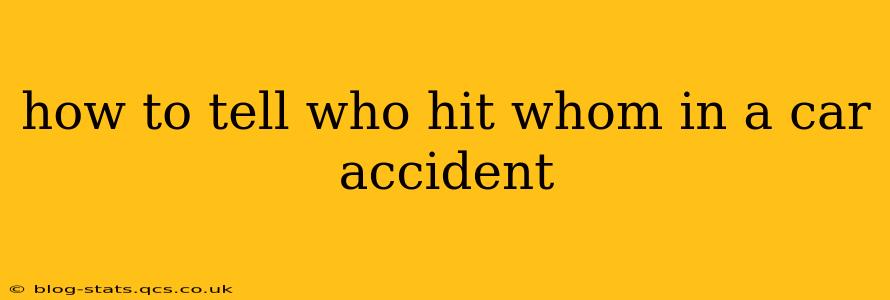How to Tell Who Hit Whom in a Car Accident
Determining fault in a car accident can be complex, even with seemingly straightforward scenarios. While eyewitness accounts and police reports are crucial, understanding the physics of a collision and examining the evidence at the scene can significantly help determine who hit whom. This guide will break down several key factors to consider.
What are the common indicators of who hit whom in a car accident?
Several factors help determine which vehicle initiated the collision. These include:
-
Vehicle Damage: The location and type of damage on each vehicle often provides significant clues. For instance, damage concentrated on the front of one car and the rear of another strongly suggests the first car struck the second. Conversely, side impact damage indicates a different collision dynamic. However, damage patterns can be misleading in complex accidents involving multiple impacts or unusual angles. A professional accident reconstructionist can interpret this complex damage.
-
Tire Marks: Skid marks, tire scuffs, and yaw marks (tire marks indicating a sideways skid) on the road surface can reveal important information about braking, speed, and the direction of travel before impact. These require careful analysis and may need professional interpretation.
-
Debris Field: The location and distribution of debris from the vehicles (broken glass, plastic, metal parts) can often indicate the point of impact and the direction of movement after the collision. Again, a careful examination is necessary.
-
Witness Testimony: Eyewitnesses can be invaluable, but their accounts should be assessed critically. Memory can be unreliable, and perspectives can differ. Multiple consistent eyewitness accounts are more reliable than a single one.
-
Police Report: The police report is a crucial document. While it may not definitively assign fault, it often contains details of the accident, including witness statements, diagrams of the scene, and the officers' observations.
-
Security Camera Footage: If security cameras captured the accident, this footage provides undeniable evidence of the sequence of events.
How do I determine fault if the cars are facing the same direction?
When vehicles are traveling in the same direction, the most likely scenario is a rear-end collision. In this case, the driver of the rear vehicle is usually at fault unless they can demonstrate that the driver ahead brake checked them unexpectedly or created an unsafe condition. However, even in rear-end collisions, nuances exist. For instance, the leading vehicle may have stopped abruptly in a place they should not have stopped, leading to partial or complete liability transfer to them.
What if there are multiple vehicles involved?
Multi-vehicle accidents can significantly complicate the determination of fault. The collision sequence and contribution of each vehicle need careful consideration. Some vehicles might have been involved in secondary impacts, making the determination more intricate. A detailed accident reconstruction is essential for understanding what happened.
Can I use photos and videos as evidence?
Yes, photos and videos are excellent sources of evidence. These should capture the overall scene, the damage to each vehicle, the location of debris, and any skid marks. High-quality, well-documented evidence can be extremely persuasive. However, it's crucial to ensure the images and videos are clear, accurate, and unbiased representations of the scene.
What should I do immediately after a car accident?
Following an accident, prioritize safety: call emergency services if anyone is injured, move vehicles to a safe location if possible, and exchange information with the other drivers, including driver's licenses, insurance details, and contact information. Take pictures and videos of the scene, damage, and surroundings. Seek medical attention, even if you feel only minor injuries, as some injuries may not manifest immediately. Contact your insurance company to report the accident promptly.
Disclaimer: This information is for educational purposes only and does not constitute legal advice. Determining fault in a car accident is a complex process, and the information above should not replace professional legal counsel or accident reconstruction. If you are involved in a car accident, consult with a qualified attorney and potentially an accident reconstruction expert.
